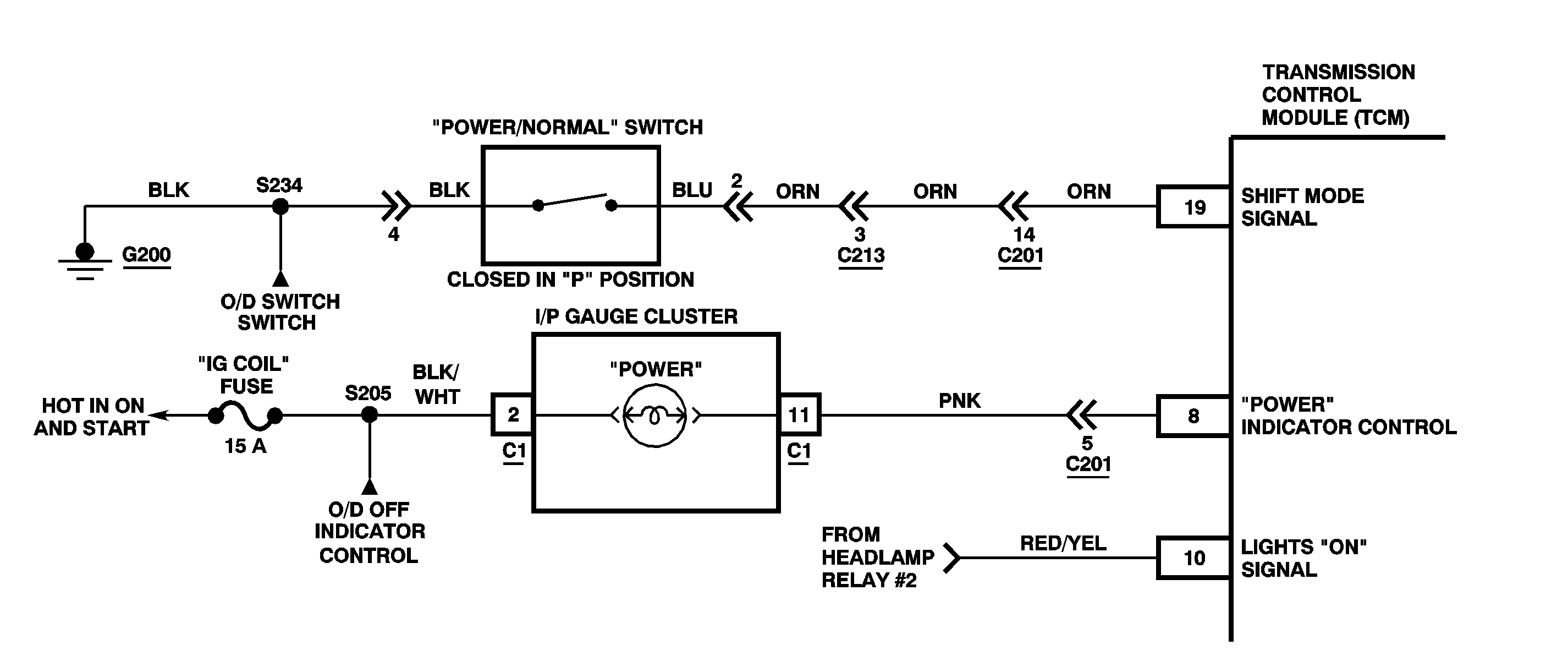
Circuit Description
When the ignition switch turns ON, the Transmission Control Module (TCM) performs a 3-second POWER indicator bulb check. The TCM performs the bulb check by grounding the POWER indicator control circuit. The Power/Normal switch button grounds the shift mode signal circuit to the TCM when the Power/Normal switch sets to POWER. The above condition causes the TCM to ground the POWER indicator control circuit. Grounding the POWER indicator control circuit turns on the POWER indicator lamp located in the instrument panel gauge cluster. The POWER indicator informs the driver that the TCM is using the Power gear shift schedule (delaying upshifting for improved acceleration). The TCM dims the POWER indicator lamp by adding additional internal resistance to the POWER indicator control output circuit when both of the following conditions occur:
| • | The POWER indicator remains on. |
| • | The parking lamps/headlamp remain on. |
Dimming the POWER indicator lamp reduces excessive glare to the driver at night. The following conditions occur after the Power/Normal switch button sets to NORMAL:
- The Power/Normal switch button removes a path to ground to the shift mode signal circuit.
- The TCM turns off the POWER indicator lamp.
- The TCM uses the Normal gear shift schedule (early upshifting for improved fuel economy).
Diagnostic Aids
Inspect for the following conditions:
| • | A short to ground in the POWER indicator control circuit between the TCM and the instrument panel gauge cluster. |
| • | A short to ground in the shift mode signal circuit between the Power/Normal switch and the TCM. |
| • | A faulty Power/Normal switch (staying closed at all times). |
| • | A faulty TCM |
Rubbed through wire insulation may cause an intermittent condition. Repeat the On-Board Diagnostic (OBD) System Check after making repairs in order to ensure that the system functions normally.
Refer to Wiring Repairs in Wiring Systems when repairing any wiring.
Test Description
The numbers below refer to the step numbers on the diagnostic table.
-
The OBD System Check prompts the technician to complete some basic checks and store the freeze frame data on the Scan Tool if applicable. The scan tool creates an electronic copy of the data taken when the fault occurred. The information then stores in the scan tool for later reference.
-
This step tests for a short to ground in the POWER indicator circuit.
-
This step determines if the following conditions exist:
-
This step verifies that the following conditions exist:
-
This step tests for proper operation of the POWER indicator.
| • | A short to ground or a constantly - closed Power/Normal switch causes the condition. |
| • | See the above figure. |
| • | A faulty TCM does not cause the condition. |
| • | A short to ground in the shift mode signal circuit causes the condition. |
| • | A faulty Power/Normal switch does not cause the condition. |
Step | Action | Value(s) | Yes | No |
|---|---|---|---|---|
Was the On-Board Diagnostic (OBD) System Check performed? | -- | |||
Does the OD/OFF indicator lamp turn on? | -- | |||
Does the test lamp turn on? | -- | |||
Does the test lamp turn on? | -- | |||
5 | Repair the short to ground in the PNK wire between the TCM and the instrument panel gauge cluster. Is the repair complete? | -- | -- | |
6 | Replace the TCM. Is the procedure complete? | -- | -- | |
7 | Replace the Power/Normal switch. Refer to Power/Normal (P/N) Switch Replacement . Is the procedure complete? | -- | -- | |
8 | Repair the short to ground in the ORN wire between the Power/Normal switch and the TCM. Is the repair complete? | -- | -- | |
Does the POWER indicator lamp turn on for approximately 3 seconds? (The indicator will remain ON with the Power/Normal switch in the Power (P) position). | -- | System OK |
